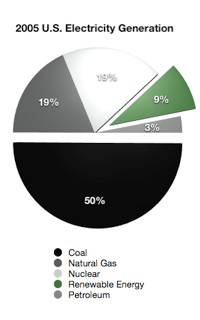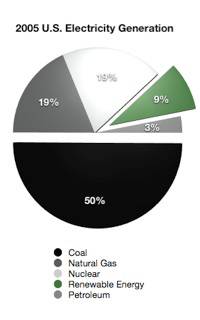ECOLEAF: Background on Renewable Energy


In 2005, only 8.9% of the total electrical energy produced in the US came from geothermal, solar, wind and hydroelectric energy. Geothermal (with no actionable growth) represents 0.37%. The number of solar and wind power plants may be increasing every year, but they nonetheless only represent 0.014% and 0.44% of the nation’s power supply. The lion’s share at 6.7% (or 75.6% of all renewable energy created) is from hydroelectric power, a technology that was commercialized over 130 years ago and which has very limited opportunities for expansion. With all the advances in new materials and electronics, it’s astounding that only a tiny fraction of the nation’s energy production can be attributed to wind and solar sources.
The arsenal of today’s renewable energy technologies is dated, static, and frighteningly small.
Global electricity consumption in 2005: 17,300,000 GWh
US electricity consumption in 2005: 3,816,000 GWh
US Hydroelectric electricity consumption in 2005: 270,320 GWh
US Biomass electricity consumption in 2005: 54,160 GWh
US Wind electricity consumption in 2005: 17,810 GWh
US Geothermal electricity consumption in 2005: 14,690 GWh
US Solar Thermal electricity consumption in 2005: 350 GWh
US Solar PV electricity consumption in 2005: 200 GWh


Revitalizing the nation’s core technological strength entails building green energy. There is no time to waste--the level of global warming is highly dependent on the actions of the United States, the largest power-consuming nation in the world. Without making the switch to obtaining a significant amount of our power from renewable sources, carbon waste will continue to suffocate our air and sully our environment.
The future needs clean, green renewable energy. This green fuel of the future will enable economical freedom, significantly reduce greenhouse gas emissions, provide clean water production, and will pave the way for the adoption of zero-emission vehicles.
BACKGROUND ON RENEWABLE ENERGY



Stay Informed
Get updates and action alerts.



back
next

Delivering Green Clarity in a Carbon-Troubled World™
Copyright © 2008 - 2010 by ECOLEAF™. All rights reserved.
Reproduction in whole or in part without permission is prohibited.